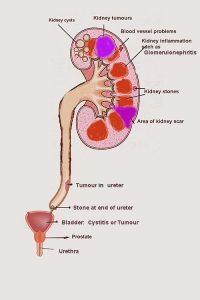| What is haematuria? What causes haematuria? Is haematuria always a bad thing? What tests are needed? What is the treatment? What if no cause is found? Further information |
|
 What is haematuria?
What is haematuria?
Haematuria means the appearance of blood in the urine. Haematuria is most commonly present in very small quantities (microscopic haematuria) and is only detected by a simple dipstick test (urine sample). Less often visible blood may appear in the urine as a brown discolouration or red.
 What causes haematuria?
What causes haematuria?
Blood should not normally appear in the urine, red blood cells are kept in the blood stream by the filtering units of the kidney the glomeruli. Any part of the urinary tract from the kidneys to the bladder and urethra may be a cause of haematuria.
Click here for an explanation of where the kidneys are and how they work.
Causes of haematuria
Haematuria can originate from the kidney itself due to inflammation in the kidney, eg glomerulonephritis affecting the filtering units (glomeruli). When this is the cause of haematuria there are often other signs of kidney disease such as:
Kidney cysts, tumours or kidney stones can also cause haematuria. Blockages or stones in the tube to the bladder (ureter) may cause haematuria. The bladder may also be the cause of haematuria, in cystitis (bladder infection), stones, or tumours in the bladder. Diseases of the prostate gland may also cause haematuria in men. Direct damage to the kidney in an accident. |

Figure modified from Davidson’s Textbook of Medicine, 18th ed., edited by C. Haslett, published by Churchill Livingstone, 1999 |
Haematuria is more common when taking medication to thin the blood ( eg Warfarin). These medications don’t cause haematuria, but can lead to more significant bleeding in the presence of an underlying cause for haematuria. It is therefore still possible that a separate problem may be causing the haematuria and other tests are still needed. Haematuria may sometimes be found in sickle cell anaemia (or even sickle cell trait).
 Is haematuria always a bad thing?
Is haematuria always a bad thing?
Haematuria may not be a important, if any of the following can explain it:
 What tests are needed?
What tests are needed?
Blood tests are done to check for a low blood count (anaemia) and that the kidney is working normally. The urine will be checked for protein and for infection.
An ultrasound scan looks at the kidneys for cysts or tumours. Sometimes, an X-Ray with a dye injection (IVU or IVP) is done.
A special test called a cystoscopy is often needed. This test uses a camera at the end of a flexible tube to examine the bladder wall. It is possible to do this test under local anaesthetic.
If after all these tests it seems that the bleeding is coming from the kidney, then a kidney biopsy may be suggested. This test involves taking a very small piece of kidney tissue and examining it under the microscope. Things that suggest that diseases of the kidney may be the cause of the bleeding include:
| protein in the urine (proteinuria) |
| high blood pressure |
| abnormal blood tests of kidney function |
 What is the treatment?
What is the treatment?
Haematuria is usually small in amount and in itself doesn’t require any treatment. The main reason for tests is to look for any definite cause of the haematuria which may require treatment. Treatment depends very much upon the underlying cause of the haematuria. Often no treatment is required.
 What if no cause is found?
What if no cause is found?
Sometimes no definite cause for the bleeding is found. Usually this means that the risk of there being a serious cause for the bleeding is very low. Where there are no signs of serious disease, occasional (every 6-24 months) monitoring of the urine, blood tests and blood pressure is usually all that is required. This is to detect the rare cases where the haematuria is an early sign of an important condition that develops later in life.
 Further information
Further information
| Proteinuria (protein in the urine) is a sign of kidney disease. More information on it, and on various types of glomerulonephritis (inflammation of the glomeruli) which may cause haematuria, is available from our EdRenINFO pages. |
| The website of the American Family Physician includes a short patient information leaflet on haematuria |
| Try The National Kidney Federation. This is a very good site which is designed for people with kidney disease. |
| Information elsewhere on this site gives guidelines for the management of haematuria (microscopic and macroscopic) for general practitioners and other specialists. Note that these are written for those with a healthcare background. |
Acknowledgements: The author of this page was Matthew King. It was first published in January 2001 and reviewed in May 2010 by Iain Drummond. The date is was last modified is shown in the footer.

